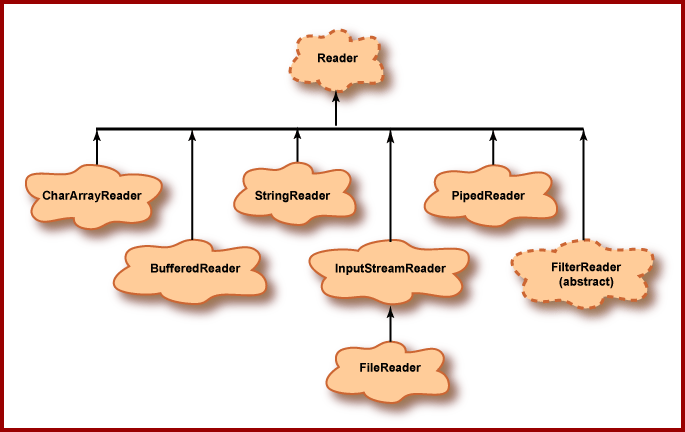In this article, we will go through CharacterStream in java.io package, how to use each class in this package efficiently.
Let’s get started.
Table of contents
- Background about character stream
- Benefits of Character streams
- InputStreamReader
- OutputStreamWriter
- BufferedReader
- BufferedWriter
- FileReader
- FileWriter
- Wrapping up
Background about character stream
JDK’s version 1.1 supported for character streams to the java.io package. Prior to JDK 1.1, the standard I/O facilities support only byte streams, via InputStream and OutputStream and subclasses.
The difference between character streams and byte streams is that Character streams contains 16-bit Unicode characters, Byte streams only contain 8-bit bytes.
Class Diagram of Character stream:


The most important concrete subclasses of Reader and Writer are the InputStreamReader and OutputStreamWriter classes.
The InputStreamReader and OutputStreamWriter classes act as decorators on top of input and output streams that change the interface from a byte-oriented interface to a character-oriented character.
In addition to these two classes, the java.io package also includes several raw reader and writer classes that read characters without directly requiring an underlying input stream. These include:
- File Reader/Writer
- String Reader/Writer
- CharArray Reader/Writer
–> File Reader/Writer works with files, and String/CharArray Reader/Writer work internally to Java.
Benefits of Character streams
-
easy to write programs that are not dependent upon a specific character encoding, and therefore easy to internationlize.
-
Character streams are potentially much more efficient then Byte streams.
The implementations of many of Java’s original byte streams are oriented around
byte-at-a-timeread and write operations. The character-stream classes, in contrast, are oriented aroundbuffer-at-a-timeread and write operations.This difference, in combination with a more efficient locking scheme, allows the character stream classes to make up for the added overhead of encoding conversion in many cases.
InputStreamReader
An InputStreamReader contains an underlying input stream from which it reads raw bytes. It translate these bytes into Unicode characters according to a specified encoding.
Its constructors specify the input stream to read and the encoding to use:
public InputStreamReader(InputStream in);
public InputStreamReader(InputStream in, String encoding) throws UnsupportedEncodingException;
OutputStreamWriter
An OutputStreamWriter receives Unicode characters from a running program. It then translates those characters into bytes using a specified encoding and writes the bytes onto an underlying output stream.
Its constructor specifies the output stream to write and the encoding to use:
public OutputStreamWriter(OutputStream out, String encoding) throws UnsupportedEncodingException;
public OutputtStreamWriter(OutputStream out);
For example:
OutputStreamWriter osw = new OutputStreamWriter(new FileOutputStream("data.txt", "Cp1253"));
...
BufferedReader
A BufferedReader reads text from a character-input stream, buffering characters so as to provide for the efficient reading of characters, arrays, and lines.
Its constructors specify the Reader to read and the buffer size may be specified:
public BufferReader(Reader in);
public BufferReader(Reader in, int sz);
In general, each read request made of a Reader causes a corresponding read request to be made of the underlying character or byte stream. It is therefore advisable to wrap a BufferedReader around any Reader whose read() operations may be costly, such as FileReader and InputStreamReader.
// Without buffering, each invocation of read() or readLine() could cause bytes to be read from the file, converted into characters, and then returned, which can be very inefficient.
BufferReader in = new BufferReader(new FileReader("test.txt"));
BufferedWriter
A BufferedWriter writes text to a character-output stream, buffering characters so as to provide for the efficient writing of single characters, arrays, and strings.
Its constructors specify the Writer to read and the buffer size may be specified:
public BufferedWriter(Writer out);
public BufferedWriter(Writer out, int sz);
In general, a Writer sends its output immediately to the underlying character or byte stream. Unless prompt output is required, it is advisable to wrap a BufferedWriter around any Writer whose write() operations may be costly, such as FileWriter and OutputStreamWriter.
// Without buffering, each invocation of a print() method would cause characters to be converted into bytes that would then be written immediately to the file, which can be very inefficient.
PrintWriter out = new PrintWriter(new BufferedWriter(new FileWriter("text.txt")));
FileReader
A FileReader is a subclass of InputStreamReader class, and it will directly read character files.
public FileReader(File file);
public FileReader(FileDescriptor fd);
public FileReader(String fileName);
FileReader is usually wrapped by BufferedReader to improve performance and provide more convenient ways to process data.
FileWriter
A FileWriter class will write character files.
public FileWriter(File file);
public FileWriter(File file, boolean append);
public FileWriter(FileDescriptor fd);
public FileWriter(String fileName);
public FileWriter(String fileName, boolean append);
As FileReader is dependent on the default system character encoding, so when we need to use different character set, buffer size, input stream, we need to use InputStreamReader.
Wrapping up
- Understand about how to use each class of character stream, when to use.
Thanks for your reading.
Refer:
https://web.mit.edu/java_v1.5.0_22/distrib/share/docs/guide/io/io.html
https://docs.oracle.com/javase/7/docs/api/java/io/BufferedWriter.html
https://docs.oracle.com/javase/7/docs/api/java/io/CharArrayWriter.html
https://docs.oracle.com/javase/7/docs/api/java/io/OutputStreamWriter.html